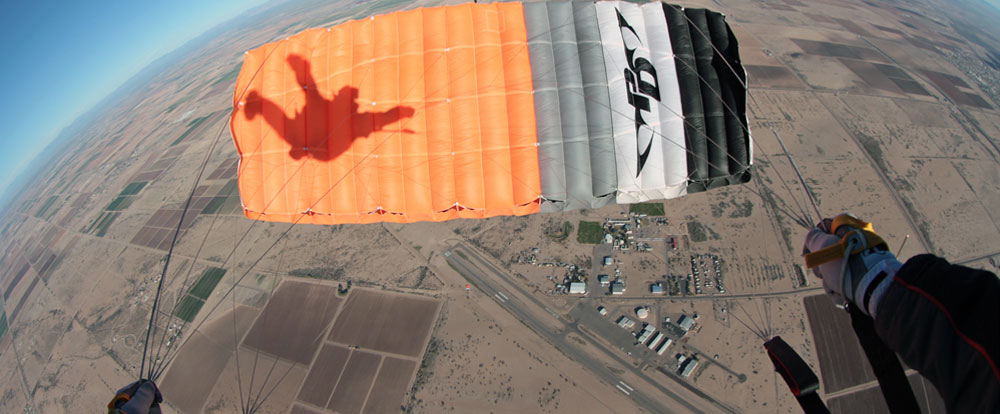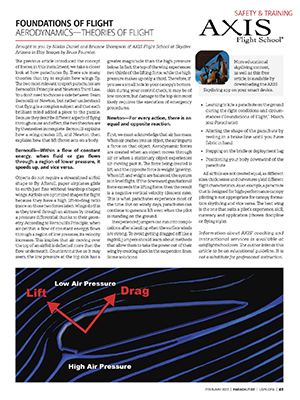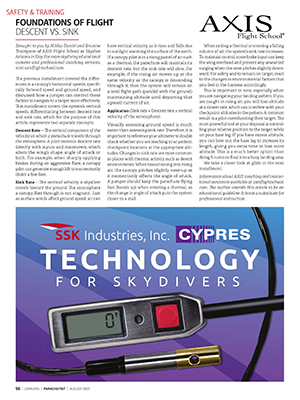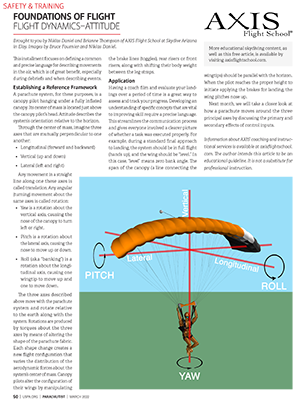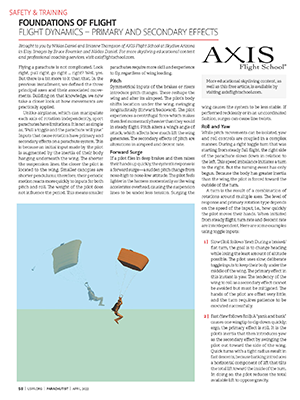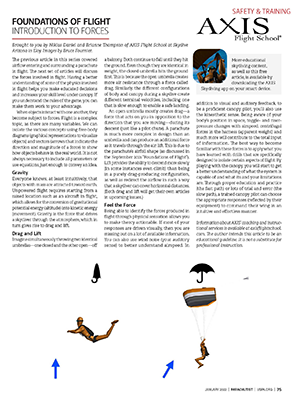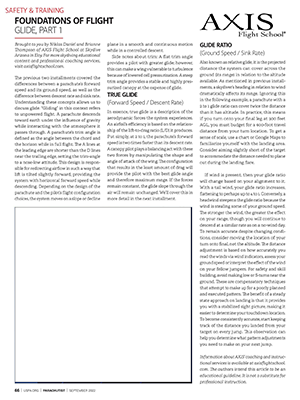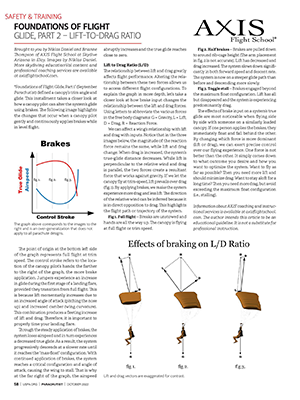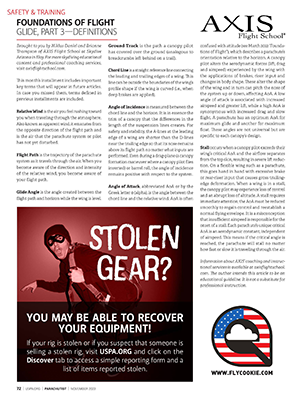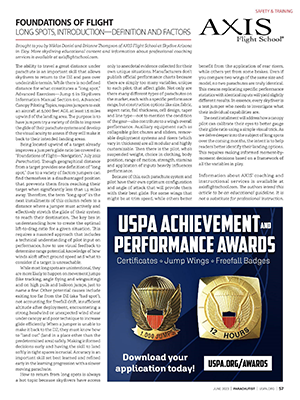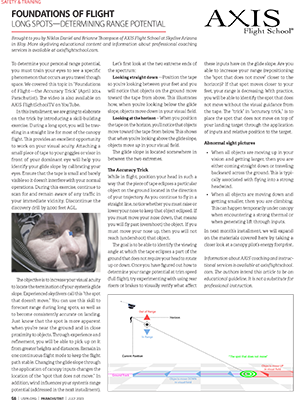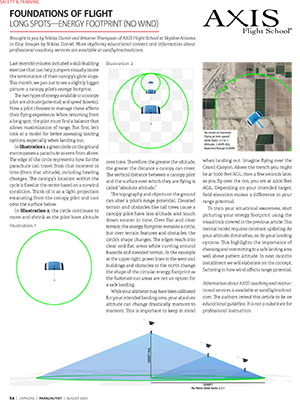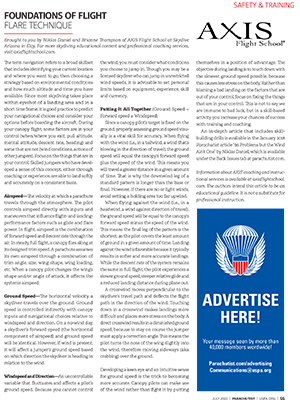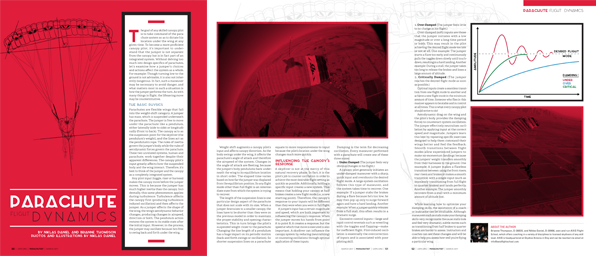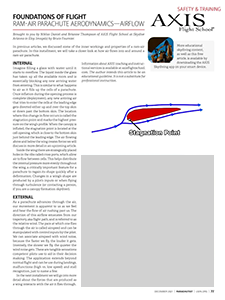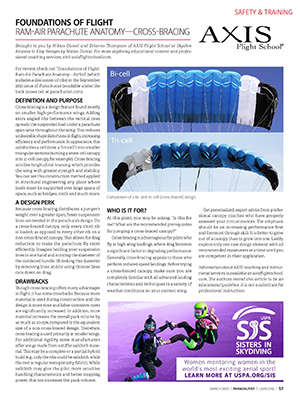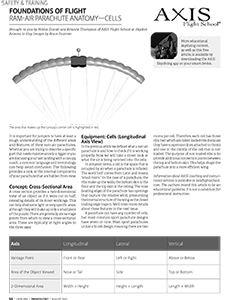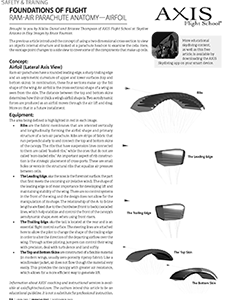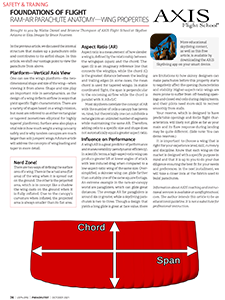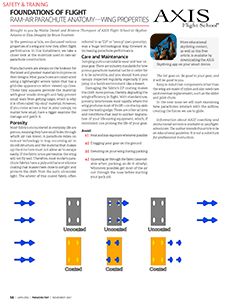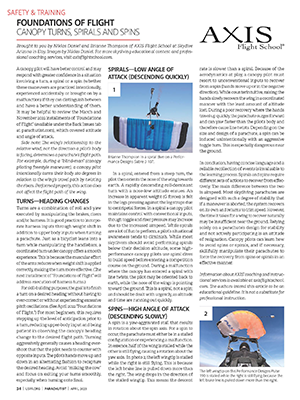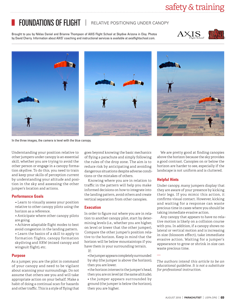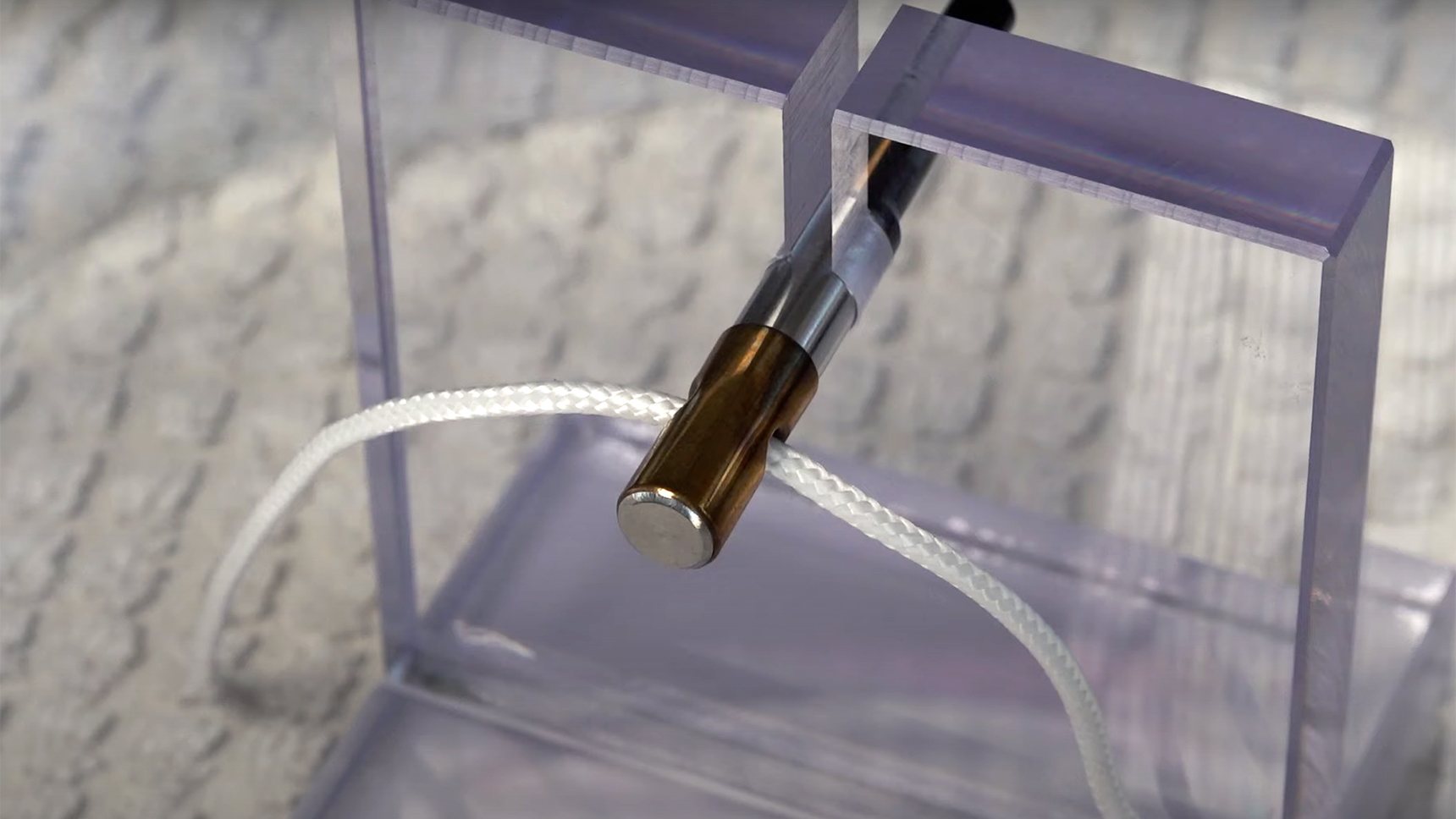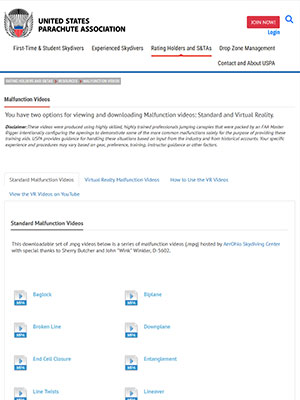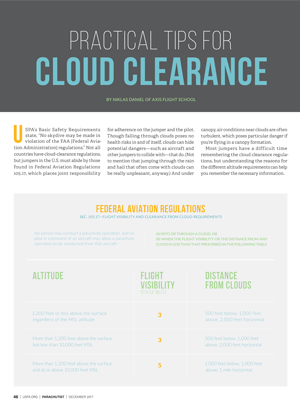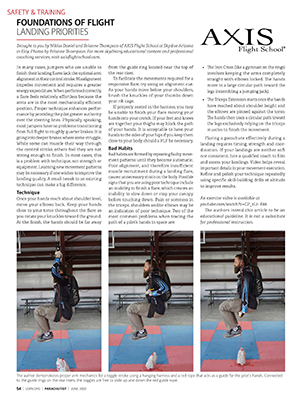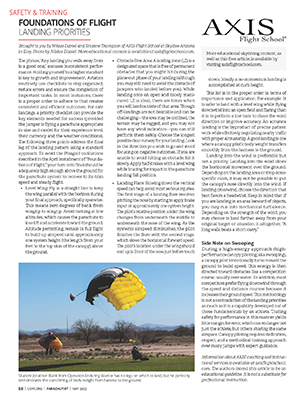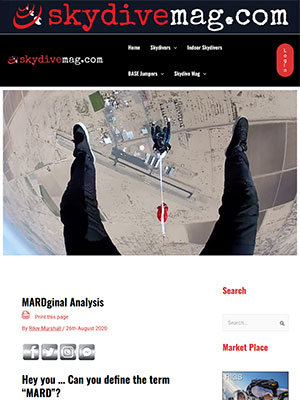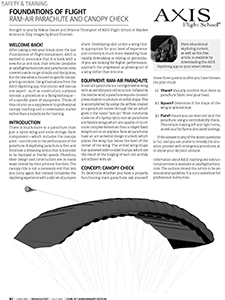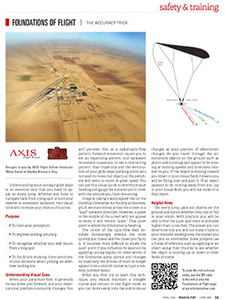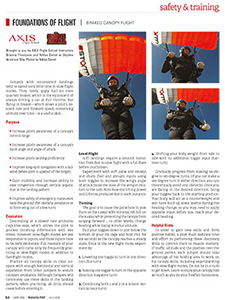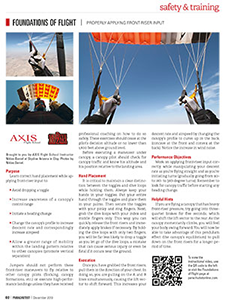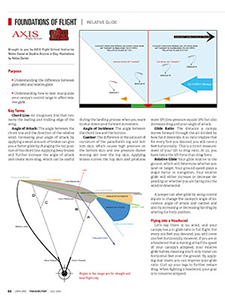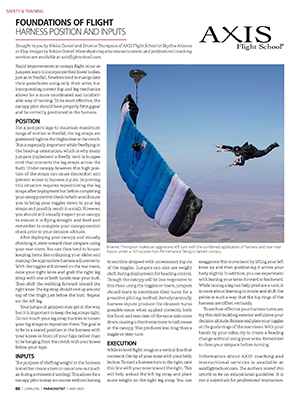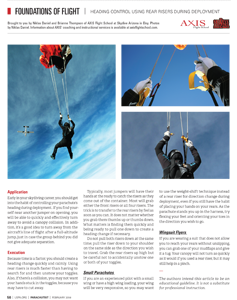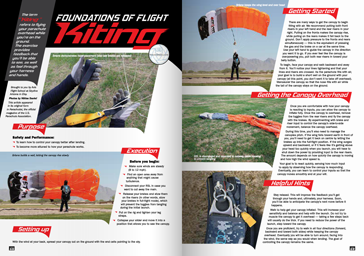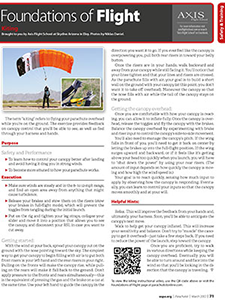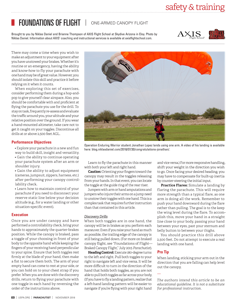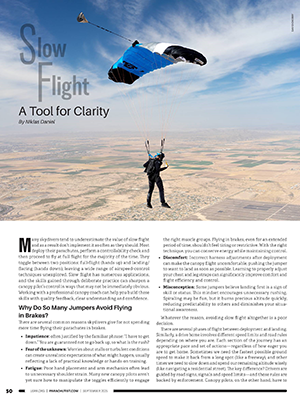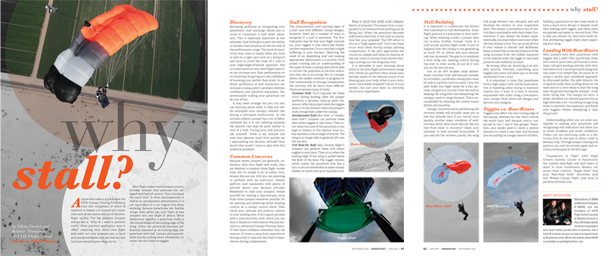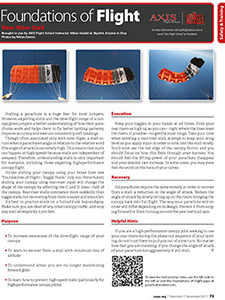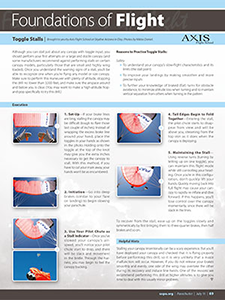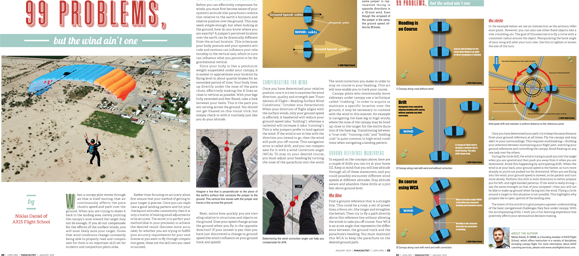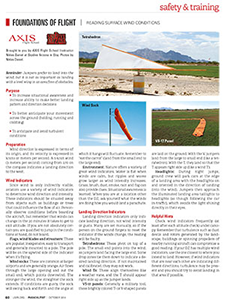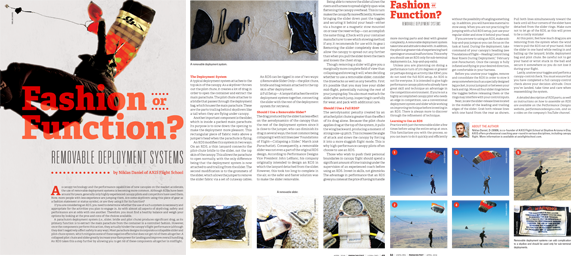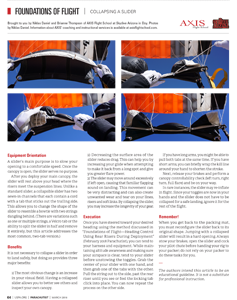Table of Contents
Jump to a chapter/section by clicking on it
or scroll through the complete topic.
Chapter 1: Introduction / Theory
Chapter 2: In-Air Canopy Skills
Chapter 3: Malfunctions
Chapter 4: Safety Issues
Chapter 5: Solo Skills
Chapter 6: XRW
Chapter 7: Equipment – CYPRES how to-series
Chapter 8: Equipment – other
Chapter 1: Introduction / Theory

Aerodynamics—Theories of Flight
Article by Niklas Daniel and Brianne Thompson. Visuals by by Bruce Fournier.
This article focuses on how parachutes fly and look at the two theories most relevant to sport parachutes: Bernouille"s principal, which explains how a wing creates lift, and Newton"s Third Law, which then explains how that lift (force) acts on a body.
[ Full Article ]

Descent vs. Sink
Article by Niklas Daniel and Brianne Thompson.
The previous installment covered the differences in a canopy's horizontal speeds, specifically forward speed and ground speed, and discussed how a jumper can control these factors to navigate to a target more effectively. This installment covers the system's vertical speeds, differentiating between descent rate and sink rate, which for the purpose of this article, represents two separate concepts.
[ Full Article ]

Flight Dynamics—Attitude
Article by Niklas Daniel and Brianne Thompson. Visuals by by Niklas Daniel and Bruce Fournier.
This installment focuses on defining a common and precise language for describing movements in the air, which is of great benefit, especially during debriefs and when describing events. This lays the basis for the next installment in this series, which will take a closer look at how a parachute moves around its three principal axes.
[ Full Article ]

Flight Dynamics—Primary and Secondary Effects
Article by Niklas Daniel and Brianne Thompson. Visuals by by Niklas Daniel.
Building on the knowledge of our previous articles, we now take a closer look at how movements are practically applied. Unlike airplanes, which can manipulate each axis of rotation independently, sport parachutes have limitations. It is not as simple as "Pull a toggle and the parachute will yaw". Inputs that cause rotation have primary and secondary effects on a parachute system. Let's take a look at that.
[ Full Article ]

Introduction to Forces
Article by Niklas Daniel and Brianne Thompson. Visuals by by Bruce Fournier.
The next set of articles will discuss the forces involved in flight. Having a better understanding of some of the physics involved in flight helps you make educated decisions and increases your skill level under canopy. If you understand the rules of the game, you can make them work to your advantage.
[ Full Article ]

Glide, Part 1
Article by Niklas Daniel and Brianne Thompson.
The previous two installments covered the differences between a parachute's forward speed and ist ground speed, as well as the difference between descent rate and sink rate. Understanding these concepts allows us to discuss glide. "Gliding" in this context refers to unpowered flight. A parachute descends towards earth under the influence of gravity while interacting with the atmosphere it passes through.
[ Full Article ]

Glide, Part 2
Article by Niklas Daniel and Brianne Thompson.
The previous installment defined a canopy's trim angle and glide. This installment takes a closer look how a canopy pilot can alter the system's glide using brakes. In this installment we will cover changes that occur when a canopy pilot gently and continuously applies brakes while in level flight and we will cover the effects of braking on the Lift to Drag Ratio.
[ Full Article ]

Glide, Part 3
Article by Niklas Daniel and Brianne Thompson.
This month's installment includes important key terms that will appear in future articles. In case you missed them, terms defined in previous installments are included.
[ Full Article ]

Long Spots, Introduction—Definition and Factors
Article by Niklas Daniel and Brianne Thompson. Visuals by Niklas Daniel.
The ability to travel a great distance under parachute is an important skill that allows skydivers to return to the DZ and pass over undesirable terrain. While there is no defined distance for what constitutes a "long spot", Advanced Exercises (Jump 5 in Skydivers Information Manual Section 6-11, Advanced Canopy Piloting Topics) requires jumpers to exit an aircraft at 5,000 feet AGL at least 1.5 miles upwind of the landing area.
[ Full Article ]


Long Spots—Determining Range Potential
Article by Niklas Daniel and Brianne Thompson. Visuals by Niklas Daniel.
To determine your personal range potential, you must train your eyes to see a specific phenomenon that occurs as you travel through space. In this installment, we are going to elaborate on the trick by introducing a skill-building exercise. We covered this topic in "Foundations of Flight—the Accuracy Trick" (April 2014 Parachutist). The video is also available on AXIS FlightSchoolTV on YouTube.
[ Full Article ]
[ Video ]

Long Spots—Energy Footpring (No Wind)
Article by Niklas Daniel and Brianne Thompson. Visuals by Niklas Daniel.
This month, we pan out to see a slightly bigger picture: a canopy pilot's energy footprint. The two types of energy available to us are altitude (potential) and speed (kinetic). How a pilot chooses to manage these affects their flying experience. When returning from a long spot, the pilot must find a balance that allows maximization of range.
[ Full Article ]

Navigation
Article by Niklas Daniel and Brianne Thompson.
The term navigation refers to a broad skillset that includes identifying your current location and where you want to go, then choosing a strategy based on environmental conditions and how much altitude and time you have available. Since most skydiving takes place within eyeshot of a landing area and in a short time frame, it is good practice to predict your navigational choices and consider your options before boarding the aircraft. …
Please ignore title in pdf ("Flaring Technique"; print error).
[ Full Article ]

Parachute Flight Dynamics
Article by Niklas Daniel and Brianne Thompson. Visuals by and illustrations by Niklas Daniel.
To become a more proficient canopy pilot, it's important to understand that the jumper is not separate from the canopy but is in fact part of an integrated system. Without delving too much into design specifics of parachutes, let's examine how a jumper's choices and actions affect the system as a whole.
[ Full Article ]

Ram-Air Parachute Anatomy—Airflow
Article by Niklas Daniel and Brianne Thompson. Visuals by by Bruce Fournier.
In previous articles, we discussed some of the inner workings and properties of a ram-air parachute. In this installment, we will take a closer look at how air flows into and around a ram-air parachute.
[ Full Article ]

Ram-Air Parachute Anatomy—Cross-Bracing
Article by Niklas Daniel and Brianne Thompson. Visuals by Niklas Daniel.
Cross-bracing is a design feature found mostly on smaller, high-performance wings. Adding extra angled ribs between the vertical ones spreads the suspended load under a parachute span-wise througout the wing. This reduces undesirable shape distortions in flight, increasing efficiency and performance.
[ Full Article ]

Ram-Air Parachute Anatomy—Cells
Article by Niklas Daniel and Brianne Thompson. Visuals by by Bruce Fournier.
It is important for jumpers to have at least a rough understanding of the different areas and features of theur ram-air parachutes. Whether you are trying to describe a specific part that needs maintenance by a rigger or you are discussing your las landing with a canopy coach, a common language and terminology can help avoid confusion. …
[ Full Article ]

Ram-Air Parachute Anatomy—Airfoil
Article by Niklas Daniel and Brianne Thompson. Visuals by by Bruce Fournier.
The previous article introduced the concept of using a two-dimensional cross-section to view an object's internal structure and looked at a parachute head-on to examine the cells. Here, the vantage point changes to a side view to cover some of the components that make up cells. …
[ Full Article ]

Ram-Air Parachute Anatomy—Wing Properties
Article by Niklas Daniel and Brianne Thompson. Visuals by by Bruce Fournier.
In this article, we shift our vantage point to view the parachute from above: One can see the wing's planform—the two-dimensional shape and size of the wing—when viewing it from above. Shape and size play an important role in aerodynamics, as the design of a wing deflects airflow in ways that yield specific flight characteristics. …
[ Full Article ]

Ram-Air Parachute Anatomy—Fabrics
Article by Niklas Daniel and Brianne Thompson. Visuals by by Bruce Fournier.
Manufacturers are always on the lookout for the latest and greatest materials to improve on their designs. Most parachutes are constructed using a lightweight woven nylon that has a grid-like appearance when viewed up close. These tiny squares provide the material with great tensile strength and help prevent small tears from getting larger, which is why it is often called "rip-stop" material. …
[ Full Article ]

Canopy Turns, Spirals and Spins
Article by Niklas Daniel and Brianne Thompson. Visuals by Niklas Daniel.
A canopy pilot will have better control and may respond with greater confidence in a situation involving a turn, a spiral or a spin (whether these maneuvers a practiced intentionally, experiences accidentally or or brought on by malfunction) if they can distinguish between and have a better understanding of them.
[ Full Article ]
Chapter 2: In-Air Canopy Skills

Relative Positioning Under Canopy
Article by Niklas Daniel and Brianne Thompson. Visuals by by David Cherry.
Understanding your position relative to other jumpers under canopy is an essential skill, whether you are trying to avoid the other person or engage in a canopy formation skydive. To do this, you need to train and keep your skills of perception current.
[ Full Article ]
Chapter 3: Malfunctions

Unusual Canopy Emergencies - Collisions and Entanglements - full brief
Video by Jim Cowan & Gravity Powered Flight.
Probably the most life-threatening situation that a ram air canopy pilot may face. How to avoid collisions. Identifying the difference between a wrap (in the fabric) with another jumper or being entangled (in the lines) with another jumper. Breaking down a complicated subject to make it easier to understand and respond to properly.

Unusual Canopy Emergencies — Dual Deployments
Article by Jim Cowan.
Here is a compilation of techniques and options to address some of the most challenging and life-threatening situations that a ram-air parachutist may encounter. These are moments when pulling the cutaway handle is not the first thing to do, and in fact, may be a fatal mistake.
[ Full Article ]

USPA videos on Malfunctions (standard videos and VR videos)
Article by USPA, with several contributors.
These videos were produced using highly skilled, highly trained professionals jumping canopies that were packed by an FAA Master Rigger intentionally configuring the openings to demonstrate some of the more common malfunctions solely for the purpose of providing these training aids. USPA provides guidance for handling these situations based on input from the industry and from historical accounts. Your specific experience and procedures may vary based on gear, preference, training, instructor guidance or other factors.
[ Full Article ]

APF Malfunctions Training Video "Cutaway! Emergency Procedures" (complete video)
Video by APF, with several contributors.
Cutaway! Australian Parachute Federation's malfunction training video is designed to be used as an educational supplement to the required first jump course.
Featuring demonstrations by Australian skydiving champion, Michael Vaughan, it shows the different types of malfunctions that can occur and how to deal with them effectively using emergency procedures.

APF Malfunctions Training Video "Cutaway! Ch 1 Good Canopy- The APFs malfunction training video."
Video by APF, with several contributors.
This Australian Parachute Federation's malfunction training video is designed to be used as an educational supplement to the required first jump course. Featuring demonstrations by Australian skydiving champion, Michael Vaughan, it shows the different types of malfunctions that can occur and how to deal with them effectively using emergency procedures.

APF Malfunctions Training Video "Cutaway! Ch 2 Routine Opening Problems."
Video by APF, with several contributors.
This Australian Parachute Federation's malfunction training video is designed to be used as an educational supplement to the required first jump course. Featuring demonstrations by Australian skydiving champion, Michael Vaughan, it shows the different types of malfunctions that can occur and how to deal with them effectively using emergency procedures.

APF Malfunctions Training Video "Cutaway! Ch 3 Decision Making Process."
Video by APF, with several contributors.
This Australian Parachute Federation's malfunction training video is designed to be used as an educational supplement to the required first jump course. Featuring demonstrations by Australian skydiving champion, Michael Vaughan, it shows the different types of malfunctions that can occur and how to deal with them effectively using emergency procedures.

APF Malfunctions Training Video "Ch 4b Emergency Procedures SOS."
Video by APF, with several contributors.
This Australian Parachute Federation's malfunction training video is designed to be used as an educational supplement to the required first jump course. Featuring demonstrations by Australian skydiving champion, Michael Vaughan, it shows the different types of malfunctions that can occur and how to deal with them effectively using emergency procedures.

APF Malfunctions Training Video "Cutaway! Ch 5 Low Speed Malfunctions."
Video by APF, with several contributors.
This Australian Parachute Federation's malfunction training video is designed to be used as an educational supplement to the required first jump course. Featuring demonstrations by Australian skydiving champion, Michael Vaughan, it shows the different types of malfunctions that can occur and how to deal with them effectively using emergency procedures.

APF Malfunctions Training Video "Cutaway! Ch 6 High Speed Malfunctions."
Video by APF, with several contributors.
This Australian Parachute Federation's malfunction training video is designed to be used as an educational supplement to the required first jump course. Featuring demonstrations by Australian skydiving champion, Michael Vaughan, it shows the different types of malfunctions that can occur and how to deal with them effectively using emergency procedures.

APF Malfunctions Training Video "Cutaway! Ch 7 Two out."
Video by APF, with several contributors.
This Australian Parachute Federation's malfunction training video is designed to be used as an educational supplement to the required first jump course. Featuring demonstrations by Australian skydiving champion, Michael Vaughan, it shows the different types of malfunctions that can occur and how to deal with them effectively using emergency procedures.

APF Malfunctions Training Video "Cutaway! Ch. 8 The Journey Begins."
Video by APF, with several contributors.
This Australian Parachute Federation's malfunction training video is designed to be used as an educational supplement to the required first jump course. Featuring demonstrations by Australian skydiving champion, Michael Vaughan, it shows the different types of malfunctions that can occur and how to deal with them effectively using emergency procedures.
Chapter 4: Safety Issues

Cloud Clearance — Practical Tips
Article by Niklas Daniel. Visuals by and illustrations by Niklas Daniel.
Most jumpers have a difficult time remembering the cloud clearance regulations [FAR 105.17]. Understanding the reasons for the different altitude requirements can help you remember the necessary information.
[ Full Article ]

Flare Technique
Article by Niklas Daniel and Brianne Thompson. Visuals by by Brianne Thompson.
In many cases, jumpers who are unable to finish their landing flares lack the optimum arm alignment in their control stroke. Misalignment impedes movement and requires a greater energy expenditure. When performed correctly, a flare feels relatively effortless because the arms are in the most mechanically efficient position. Proper technique enhances performance by providing the pilot greater authority over the steering lines.
[ Full Article ]

Hard Openings: A Discussion with John LeBlanc
Video by Performance Designs.
John LeBlanc sits down to talk about all the factors that can contribute to hard openings and what you the jumper can do to help ensure nice openings.

Landing Priorities
Article by Niklas Daniel and Brianne Thompson. Visuals by by Niklas Daniel.
The phrase, "Any landing you walk away from is a good one", excuses inconsistent performance. Holding yourself to a higher standard is key to growth and improvement. Aviators routinely use checklists to stay organized, reduce errors and ensure the completion of important tasks. For safe landings, a priority checklist can provide the key elements needed for success …
[ Full Article ]

MARDginal Analysis
Article by Riley Marschall.
Hey you … Can you define the term “MARD”?
– Do you know what it does?
– how it works?
– and what distinguishes it from similar systems?
If you answered 'No' to any of these questions, you're not alone!
[ Full Article ]

Ram-Air Parachute and Canopy Check
Article by Niklas Daniel and Brianne Thompson. Visuals by by Bruce Fournier.
There is much more to a parachute than just a nylon wing and some strings. Each component—which includes the canopy pilot—contributes to the performance of the parachute. The canopy ride is not a necessary evil that lets you jump again, but instead completes the skydiving experience with a skill set all jumpers share. Developing skills under a wing that is appropriate for your level of experience and currency is much more rewarding than rapidly downsizing or relying on gimmicks.
[ Full Article ]
Chapter 5: Solo Skills


The Accuracy Trick
Article by Niklas Daniel. Visuals by by Niklas Daniel.
Understanding your canopy's glide slope is an essential skill that you need to apply on every jump. Whether you have to navigate back from a long spot or land your reserve in someone's backyard, this visual trick will increase your chance of success.
[ Full Article ]
[ Video ]

Braked Canopy Flight
Article by Brianne Thompson and Niklas Daniel. Visuals by by Niklas Daniel.
The purpose of this drill is to increase a pilot's awareness of a canopy's control range, awareness of a canopy's bank angle and angle of attack, landing proficiency, and long-spot navigation with a tail-wind. It also helps to gain mobility and increase the ability to ease congestion in the landing pattern as well as improve safety of emergency maneuvers near the ground.
[ Full Article ]

Descent vs. Sink
Article by Niklas Daniel and Brianne Thompson.
The previous installment covered the differences in a canopy's horizontal speeds, specifically forward speed and ground speed, and discussed how a jumper can control these factors to navigate to a target more effectively. This installment covers the system's vertical speeds, differentiating between descent rate and sink rate, which for the purpose of this article, represents two separate concepts.
[ Full Article ]

Flare Technique
Article by Niklas Daniel and Brianne Thompson. Visuals by by Brianne Thompson.
In many cases, jumpers who are unable to finish their landing flares lack the optimum arm alignment in their control stroke. Misalignment impedes movement and requires a greater energy expenditure. When performed correctly, a flare feels relatively effortless because the arms are in the most mechanically efficient position. Proper technique enhances performance by providing the pilot greater authority over the steering lines.
[ Full Article ]


Properly Applying Front-Riser Input
Article by Niklas Daniel. Visuals by by Niklas Daniel.
Learn correct hand placement while applying front-riser input to: avoid dropping a toggle, increase awareness of a canopy's control range, initiate a heading change, change the canopy's profile to increase descent rate and correspondingly increase airspeed, and allow a greater range of mobility within the landing pattern relative to other canopies.
[ Full Article ]
[ Video ]

Glide, Part 1
Article by Niklas Daniel and Brianne Thompson.
The previous two installments covered the differences between a parachute's forward speed and ist ground speed, as well as the difference between descent rate and sink rate. Understanding these concepts allows us to discuss glide. "Gliding" in this context refers to unpowered flight. A parachute descends towards earth under the influence of gravity while interacting with the atmosphere it passes through.
[ Full Article ]

Glide, Part 2
Article by Niklas Daniel and Brianne Thompson.
The previous installment defined a canopy's trim angle and glide. This installment takes a closer look how a canopy pilot can alter the system's glide using brakes. In this installment we will cover changes that occur when a canopy pilot gently and continuously applies brakes while in level flight and we will cover the effects of braking on the Lift to Drag Ratio.
[ Full Article ]

Glide, Part 3
Article by Niklas Daniel and Brianne Thompson.
This month's installment includes important key terms that will appear in future articles. In case you missed them, terms defined in previous installments are included.
[ Full Article ]


Relative Glide
Article by Niklas Daniel. Visuals by and illustrations by Niklas Daniel.
Understanding the difference between glide ratio and relative glide as well as how to best manipulate your canopy's control range to affect relative glide.
[ Full Article ]
[ Video ]

Harness Position and Inputs
Article by Niklas Daniel and Brianne Thompson. Visuals by Niklas Daniel.
Rapid improvements in canopy flight occur as jumpers learn to incorporate their lower bodies; just as in freefall. Newbies tend to manipulate their parachutes using only their arms, but incorporating correct hip and leg mechanics allow for a more coordinated and comfortable way of moving.
[ Full Article ]

Heading Control Using Rear Risers During Deployment
Article by Niklas Daniel and Brianne Thompson. Visuals by by Niklas Daniel.
If you find your-self near another jumper on opening, you will be able to quickly and effectively turn away to avoid a canopy collision. In addition, it's a good idea to turn away from the aircraft's line of flight after a full-altitude jump, just in case the group behind you did not give adequate separation.
[ Full Article ]

Kiting
Article by Niklas Daniel. Visuals by by Niklas Daniel.
The term "Kiting" refers to flying your parachute overhead while you're on the ground. The exercise provides feedback that you'llbe able to see, as well as feel through your harness and hands.
[ Full Article ]


Kiting
Article by Niklas Daniel. Visuals by by Niklas Daniel.
Learn how to control your canopy better after landing and avoid having it drag you in strong winds and become more attuned to how your parachute works.
[ Full Article ]
[ Video ]

Landing Priorities
Article by Niklas Daniel and Brianne Thompson. Visuals by by Niklas Daniel.
The phrase, "Any landing you walk away from is a good one", excuses inconsistent performance. Holding yourself to a higher standard is key to growth and improvement. Aviators routinely use checklists to stay organized, reduce errors and ensure the completion of important tasks. For safe landings, a priority checklist can provide the key elements needed for success …
[ Full Article ]

Long Spots, Introduction—Definition and Factors
Article by Niklas Daniel and Brianne Thompson. Visuals by Niklas Daniel.
The ability to travel a great distance under parachute is an important skill that allows skydivers to return to the DZ and pass over undesirable terrain. While there is no defined distance for what constitutes a "long spot", Advanced Exercises (Jump 5 in Skydivers Information Manual Section 6-11, Advanced Canopy Piloting Topics) requires jumpers to exit an aircraft at 5,000 feet AGL at least 1.5 miles upwind of the landing area.
[ Full Article ]


Long Spots—Determining Range Potential
Article by Niklas Daniel and Brianne Thompson. Visuals by Niklas Daniel.
To determine your personal range potential, you must train your eyes to see a specific phenomenon that occurs as you travel through space. In this installment, we are going to elaborate on the trick by introducing a skill-building exercise. We covered this topic in "Foundations of Flight—the Accuracy Trick" (April 2014 Parachutist). The video is also available on AXIS FlightSchoolTV on YouTube.
[ Full Article ]
[ Video ]

Long Spots—Energy Footpring (No Wind)
Article by Niklas Daniel and Brianne Thompson. Visuals by Niklas Daniel.
This month, we pan out to see a slightly bigger picture: a canopy pilot's energy footprint. The two types of energy available to us are altitude (potential) and speed (kinetic). How a pilot chooses to manage these affects their flying experience. When returning from a long spot, the pilot must find a balance that allows maximization of range.
[ Full Article ]

One-armed Canopy Flight
Article by Niklas Daniel and Brianne Thompson. Visuals by by Niklas Daniel.
There may come a time when you wish to make an adjustment to your equipment after you have unstowed your brakes. Whether it's routine or an emergency, having the ability and know-how to fly your parachute with one hand may be of great value.
[ Full Article ]

Ram-Air Parachute and Canopy Check
Article by Niklas Daniel and Brianne Thompson. Visuals by by Bruce Fournier.
There is much more to a parachute than just a nylon wing and some strings. Each component—which includes the canopy pilot—contributes to the performance of the parachute. The canopy ride is not a necessary evil that lets you jump again, but instead completes the skydiving experience with a skill set all jumpers share. Developing skills under a wing that is appropriate for your level of experience and currency is much more rewarding than rapidly downsizing or relying on gimmicks.
[ Full Article ]

Slow Flight — A Tool for Clarity
Article by Niklas Daniel. Visuals by Niklas Daniel.
Many skydivers tend to underestimate the value of slow flight and as a result don't implement it as often as they should. Most deploy their parachutes, perform a controllability check and then proceed to fly at full flight for the majority of the time. They toggle between two positions: full flight (hands up) and landing/flaring (hands down), leaving a wide range of airspeed-control techniques unexplored. Slow flight has numerous applications, and the skills gained through deliberate practice can sharpen a canopy pilot's control in ways that may not be immediately obvious.
[ Full Article ]

Why Stall?
Article by Niklas Daniel and Brianne Thompson. Visuals by by Niklas Daniel.
Anyone who takes a quick look at the USPA Canopy Piloting Proficiency Card will notice that most of the maneuvers are of the slowflight variety. The big question is, "Why do I need to perform stalls? What practical application does it offer?" Learning more about slow flight and stalls not only prepares you to land your parachute better, but also teaches you just how versatile your wing can be.
[ Full Article ]


Rear-Riser Stall
Article by Niklas Daniel and Brianne Thompson. Visuals by by Paul Youcupicio.
Stalling a parachute is a huge fear for most jumpers. However, exploring stalls and the slow-flight range of a canopy gives jumpers a better understanding of how their parachutes work and helps them to fly better landing patterns, improve accuracy and execute consistently soft landings.
[ Full Article ]
[ Video ]

Toggle Stalls
Article by Niklas Daniel and Brianne Thompson. Visuals by by Niklas Daniel.
Reasons to practice toggle Stalls are to understand your canopy's slow-flight characteristics and its limits (the stall point), to improve your landings by making smoother and more precise inputs, to further your knowledge of braked (flat) turns for obstacle avoidance, and to minimize altitude loss when turning and to maintain vertical separation from others when turning in the pattern.
[ Full Article ]

Canopy Turns, Spirals and Spins
Article by Niklas Daniel and Brianne Thompson. Visuals by Niklas Daniel.
A canopy pilot will have better control and may respond with greater confidence in a situation involving a turn, a spiral or a spin (whether these maneuvers a practiced intentionally, experiences accidentally or or brought on by malfunction) if they can distinguish between and have a better understanding of them.
[ Full Article ]

Land unter — (Water Landings Training - German Edition)
Article by Niklas Daniel and Brianne Thompson. Visuals by by Samantha Schwann.
Die Bezeichnung Sky Diving bekommt eine dramatisch andere Bedeutung, wenn ein Springer bei der Landung – statt festen Boden zu spÜren – weit mehr als nur nasse FÜße bekommt. Damit es in einer solchen Ausnahmesituation nicht „drunter und drÜber“ geht, sondern rein und zÜgig wieder raus, empfiehlt sich eine entsprechende Vorbereitung.
[ Full Article ]


Training for Water Landings — More Than Just a Sign-Off
Article by Niklas Daniel and Brianne Thompson. Visuals by by Samantha Schwann.
Training for intentional and unintentional water landings is an important part of a skydiver's learning progression and is required to receive the USPA B license. Unfortunately, most jumpers rarely give it much thought after their instructors sign them off for this skill, and few take the time to carefully consider the dangers involved.
[ Full Article ]
[ Video ]

99 Problems, but the Wind ain't One (French and English)
Article by Niklas Daniel. Visuals by by Niklas Daniel.
See above. The content is available in French and English.
[ Full Article ]

99 Problems, but the Wind ain't One
Article by Niklas Daniel. Visuals by by Niklas Daniel.
When a canopy pilot moves through air that is itself moving, that air continuously affects the parachute's speed and path over the ground. When you are trying to make it back to the landing area, merely pointing the canopy's nose toward the target may not be enough.
[ Full Article ]

Reading Surface Wind Conditions
Article by Niklas Daniel. Visuals by by Niklas Daniel.
Increase situational awareness and increase ability to make better landing pattern and direction decisions. Better anticipate your movement across the ground (holding, running and crabbing). Anticipate and avoid turbulent conditions.
[ Full Article ]
Chapter 6: XRW

XRW — Mixed Formation Flights
Article by Niklas Daniel, Barry Holubeck and Will Kitto. Visuals by by Barry Holubeck and Will Kitto; Diagrams by Niklas Daniel.
A wing-suit flying relative to a canopy is not a new concept; however in the past it has always been considered a stunt rather than a potential discipline. As wing-suit and canopy technology continues to rapidly improve, we can almost guarantee that mixed formation flights will become more commonplace in the future. Therefore it is imperative that we take a closer look at what makes this activity possible and address some of the potential dangers associated with it. This form of flight is very new and safety is of great concern. By no means are we experts on the subject, but we would like to share some of the information we have accumulated over the last year during our training camps.
[ Full Article ]
Chapter 7: Equipment – CYPRES how to-series

What is an AAD?
Video by Niklas Daniel and Brianne Thompson.
AXIS Flight School instructional video series
CYPRES How to – video 1:
«What is an AAD?»

AAD Activation Altitudes of Leaders
Article by Alethia Austion.
For most of us, at some point we'll find ourselves in a malfunction that requires some very important, quick decision-making. The time we take on the ground to rehearse our EPs, consider and set our hard decks, think about and work out various scenarios and solutions and set our AADs to our chosen altitude is how we can be as prepared as possible for when that malfunction arises.
[ Full Article ]

Switching On and Off
Video by Niklas Daniel and Brianne Thompson.
AXIS Flight School instructional video series
CYPRES How to – video 2:
«Switching On and Off»

CYPRES Models
Video by Niklas Daniel and Brianne Thompson.
AXIS Flight School instructional video series
CYPRES How to – video 3:
«CYPRES Models»

Changing modes on C-model
Video by Niklas Daniel and Brianne Thompson.
AXIS Flight School instructional video series
CYPRES How to – video 4:
«Changing modes on C-model»

Changing the Scale
Video by Niklas Daniel and Brianne Thompson.
AXIS Flight School instructional video series
CYPRES How to – video 5:
«Changing the Scale»

Setting the Activation Altitude
Video by Niklas Daniel and Brianne Thompson.
AXIS Flight School instructional video series
CYPRES How to – video 6:
«Setting the Activation Altitude»

DZ Offset
Video by Niklas Daniel and Brianne Thompson.
AXIS Flight School instructional video series
CYPRES How to – video 7:
«DZ Offset»

Unit Information
Video by Niklas Daniel and Brianne Thompson.
AXIS Flight School instructional video series
CYPRES How to – video 8:
«Unit Information»

Traveling with a CYPRES outfitted rig
Video by Niklas Daniel and Brianne Thompson.
AXIS Flight School instructional video series
CYPRES How to – video 9:
«Traveling with a CYPRES outfitted rig»

AAD information for jump pilots
Video by Niklas Daniel and Brianne Thompson.
AXIS Flight School instructional video series
CYPRES How to – video 10:
«AAD information for jump pilots»

Is there anything a CYPRES cutter cannot cut though?
Video by Niklas Daniel and Brianne Thompson.
AXIS Flight School instructional video series
CYPRES How to – video 11:
«Is there anything a CYPRES cutter cannot cut though?»

Cypres Error and Information Codes
Article by Cypres.
List of CYPRES error codes and informational codes with explanation
[ Full Article ]
Chapter 8: Equipment – other

Comp Velocity Packing
Video by Performance Designs.
Jessica Edgeington of the PD Factory Team shows us how she packs her Comp Velocity with RDS.

Flight Dynamics—Attitude
Article by Niklas Daniel and Brianne Thompson. Visuals by by Niklas Daniel and Bruce Fournier.
This installment focuses on defining a common and precise language for describing movements in the air, which is of great benefit, especially during debriefs and when describing events. This lays the basis for the next installment in this series, which will take a closer look at how a parachute moves around its three principal axes.
[ Full Article ]

Flight Dynamics—Primary and Secondary Effects
Article by Niklas Daniel and Brianne Thompson. Visuals by by Niklas Daniel.
Building on the knowledge of our previous articles, we now take a closer look at how movements are practically applied. Unlike airplanes, which can manipulate each axis of rotation independently, sport parachutes have limitations. It is not as simple as "Pull a toggle and the parachute will yaw". Inputs that cause rotation have primary and secondary effects on a parachute system. Let's take a look at that.
[ Full Article ]

Introduction to Forces
Article by Niklas Daniel and Brianne Thompson. Visuals by by Bruce Fournier.
The next set of articles will discuss the forces involved in flight. Having a better understanding of some of the physics involved in flight helps you make educated decisions and increases your skill level under canopy. If you understand the rules of the game, you can make them work to your advantage.
[ Full Article ]

Hard Openings: A Discussion with John LeBlanc
Video by Performance Designs.
John LeBlanc sits down to talk about all the factors that can contribute to hard openings and what you the jumper can do to help ensure nice openings.

Line Types – Part 3 — Microline (Spectra)
Video by Performance Designs.
John LeBlanc of Performance Designs talks about Microline (Spectra) line.

Locking Stow Myth
Video by Performance Designs.
Nick Grillet from Performance Designs debunks the myth that double locking line stows will cause a bag lock.

MARDginal Analysis
Article by Riley Marschall.
Hey you … Can you define the term “MARD”?
– Do you know what it does?
– how it works?
– and what distinguishes it from similar systems?
If you answered 'No' to any of these questions, you're not alone!
[ Full Article ]

Method to Measure Your Slider
Video by Performance Designs.
Gilles, from PD's R&D Department, takes us through the proper way to measure your slider.

Ram-Air Parachute Anatomy—Airflow
Article by Niklas Daniel and Brianne Thompson. Visuals by by Bruce Fournier.
In previous articles, we discussed some of the inner workings and properties of a ram-air parachute. In this installment, we will take a closer look at how air flows into and around a ram-air parachute.
[ Full Article ]

Ram-Air Parachute Anatomy—Cross-Bracing
Article by Niklas Daniel and Brianne Thompson. Visuals by Niklas Daniel.
Cross-bracing is a design feature found mostly on smaller, high-performance wings. Adding extra angled ribs between the vertical ones spreads the suspended load under a parachute span-wise througout the wing. This reduces undesirable shape distortions in flight, increasing efficiency and performance.
[ Full Article ]

Ram-Air Parachute and Canopy Check
Article by Niklas Daniel and Brianne Thompson. Visuals by by Bruce Fournier.
There is much more to a parachute than just a nylon wing and some strings. Each component—which includes the canopy pilot—contributes to the performance of the parachute. The canopy ride is not a necessary evil that lets you jump again, but instead completes the skydiving experience with a skill set all jumpers share. Developing skills under a wing that is appropriate for your level of experience and currency is much more rewarding than rapidly downsizing or relying on gimmicks.
[ Full Article ]

Ram-Air Parachute Anatomy—Cells
Article by Niklas Daniel and Brianne Thompson. Visuals by by Bruce Fournier.
It is important for jumpers to have at least a rough understanding of the different areas and features of theur ram-air parachutes. Whether you are trying to describe a specific part that needs maintenance by a rigger or you are discussing your las landing with a canopy coach, a common language and terminology can help avoid confusion. …
[ Full Article ]

Ram-Air Parachute Anatomy—Airfoil
Article by Niklas Daniel and Brianne Thompson. Visuals by by Bruce Fournier.
The previous article introduced the concept of using a two-dimensional cross-section to view an object's internal structure and looked at a parachute head-on to examine the cells. Here, the vantage point changes to a side view to cover some of the components that make up cells. …
[ Full Article ]

Ram-Air Parachute Anatomy—Wing Properties
Article by Niklas Daniel and Brianne Thompson. Visuals by by Bruce Fournier.
In this article, we shift our vantage point to view the parachute from above: One can see the wing's planform—the two-dimensional shape and size of the wing—when viewing it from above. Shape and size play an important role in aerodynamics, as the design of a wing deflects airflow in ways that yield specific flight characteristics. …
[ Full Article ]

Ram-Air Parachute Anatomy—Fabrics
Article by Niklas Daniel and Brianne Thompson. Visuals by by Bruce Fournier.
Manufacturers are always on the lookout for the latest and greatest materials to improve on their designs. Most parachutes are constructed using a lightweight woven nylon that has a grid-like appearance when viewed up close. These tiny squares provide the material with great tensile strength and help prevent small tears from getting larger, which is why it is often called "rip-stop" material. …
[ Full Article ]

Removable Deployment Systems — Fashion or Function?
Article by Niklas Daniel. Visuals by by Niklas Daniel.
Where previously only highly experienced canopy pilots have used a RDS, now more skydivers with less experience are jumping them. Are they using this piece of gear as a fashion statement or status symbol, or are they using it for its function?
[ Full Article ]

How To: PD Rigger Roll
Video by Performance Designs.
Key video moments: Take the canopy by the packing tabs shaking; Fold the nose over backing each style on top; Take the trailing edge of the canopy at the seed line; pull the slider through the last loop of the daisy chain; slide the plastic bag over the canopy.

Safety Day Canopy Inspection
Video by Performance Designs.
Safety Day is here! Get basic guidelines on how to inspect your canopy. PD wants you to be safe and have fun. The more you know, the safer you are.

Semistowless Bag Line Stowage
Video by UPT, Greg Rau.
Key video moments: Pack the canopy into the bag; stow the lines on top of the bag; bring the lines down to the center of the bag; rotate the bag on top of the lines.

Collapsing a Slider
Article by Niklas Daniel and Brianne Thompson. Visuals by by Niklas Daniel.
Unlike a standard slider, a collapsible slider has two sewn-in channels that each contain a cord with a tab that sticks out the trailing side. This allows you to change the shape of the slider to resemble a bowtie with two strings dangling behind. Learn about the benefits and the execution of collapsing a slider.
[ Full Article ]

Attaching Toggles with a Finger Trapped Loop
Video by Performance Designs.
See the factory method for attaching toggles using a finger trapped loop.
